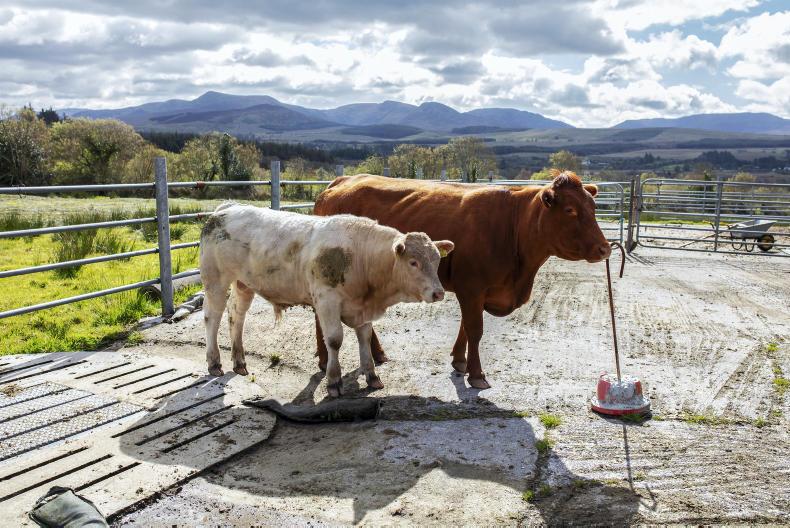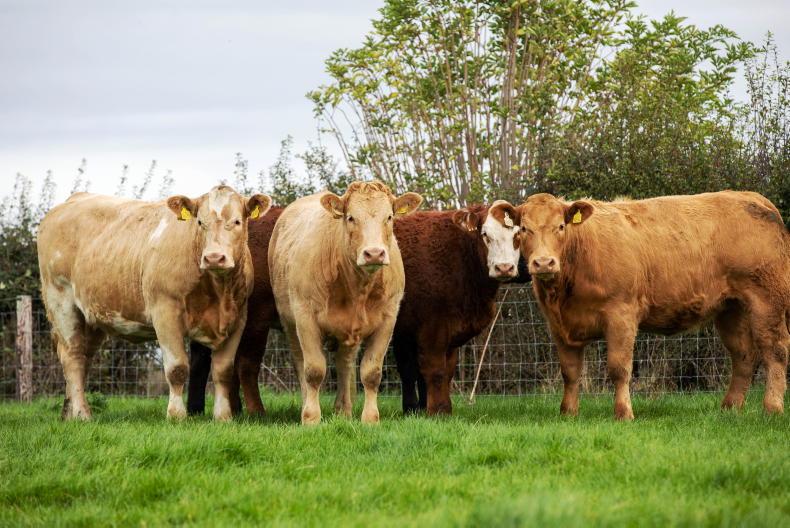ICBF has recently posted out five-year trend reports to 24,500 BDGP participants, and they make for interesting reading. There are some that say BDGP was a disaster, reducing the quality of cattle in marts and forcing farmers to keep poorer-quality animals. If we take a look at some key performance indicators that drive profitability in beef herds, we can see that progress is being made.
Non-BDGP herds
ICBF also generated reports for suckler herds not participating in BDGP as part of the analysis. Table 2 details the average improvements for non-BDGP herds and shows that the rates of gain are lower than those of BDGP herds.
Herds participating in BDGP are experiencing higher rates of gain than non-BDGP herds across a number of KPIs, as detailed in Tables 1 and 2.
Gains on replacement index of both cows and first-calving heifers are €4 and €6 higher, respectively. BDGP herds have improved calving interval by four days, with calves/cow/year increasing at the same rate – though non-BDGP herds are coming from a lower base. The percentage of heifers calved at 22-26 months has improved by 3% more in BDGP herds. There is very little move on six-week calving rate across both sets of herds. This is a new KPI in the beef calving report and is a relatively new concept to many beef farmers. The six-week calving rate is higher in non-BDGP herds, but it has to be noted that these herds are significantly smaller, with an average of 16 cows versus an average of 26 cows in BDGP herds. ICBF says that smaller herds have an advantage when it comes to achieving a higher six-week calving rate.
When asked about the improved performance of non-BDGP herds, Andrew Cromie noted the following: “It’s great to see that even non-BDGP herds are availing of the positive impacts of the scheme. This is through the increased availability of AI bulls, breeding bulls and replacement females, with these genetics now filtering through into non-BDGP herds, as well as herds involved in the scheme. It serves to highlight the powerful impact that schemes focused on breeding can have on the entire national herd”.
Change in herd size
It is interesting to note the change in cow numbers in the period. BDGP herds had an average of 26 cows in 2018, an increase of two over the 2014 average of 24 cows. Non-BDGP herds have decreased in size over the same period, with the average herd falling to 16 cows in 2018 from 17 cows in 2014.
“The Beef Data and Genomics Programme (BDGP) was launched in June 2015. Replacement heifers bred on the back of better breeding decisions since the start of the programme are now starting to calve down, therefore this analysis gives a very early picture of where the BDGP is taking the national suckler herd.
“As more and more high-index replacements enter the national herd and the upward trajectory of the replacement index continues, further significant gains should be made in key efficiency metrics such as calving interval and calves/cow/year,” commented Andrew Cromie.
BEEP weighing data
The analysis is based on 17,375 valid cow and calf weight records collected from 1,265 participating herds, since the programme started in mid-March. In undertaking this analysis, ICBF has made a number of assumptions, which are relevant for the suckler cow that it anticipates will be here in 2030.
The first is that cows will be ranked genetically on the ICBF replacement index. Secondly, ICBF assumes that cows will be suckler bred and won’t be secondary outcomes (or by-products) of the dairy herd. The final assumption is that all animals will be genotyped with this foundational ancestry data, then combined with actual performance data on the animals themselves (through programs such as BDGP and BEEP), to give the most comprehensive dataset worldwide on the current and future performance of suckler-bred animals.
So, what does the cow and calf data says with regard to the suckler cow of 2030? Restricting the analysis to just (i) suckler bred females, (ii) genotyped animals, and (iii) cows with a calf weight record at approximately 200 days, resulted in a dataset for analysis of 6,662 cow and calf records from 925 herds. This is the average performance of these cows and their progeny.
Data from the analysis indicates that the average suckler cow has a replacement index of €89. She weighs 633kg, with a 200-day calf weight of 280kg, resulting in a weanling efficiency of 44%. These cows are just over six years of age and have calved their first calf at 29.8 months, with an average calving interval of 386 days.
As a result of BDGP, the average replacement index of first-calving females is now increasing at €5-€6/year
Looking at the carcase performance of other progeny slaughtered from these same cows indicates that, on average, their offspring slaughtered at 23.4 months with a carcase weight of 381kg and graded a U-.
So how does the performance of these cows and calves compare with that of the highest genetic merit animals on farms – the next generation cows?
As a result of BDGP, the average replacement index of first-calving females is now increasing at €5-€6/year. Taking 11 years of genetic gain, this suggests that the average suckler cow should have a replacement index of €166 by 2030. Restricting the analysis to the highest genetic merit cows in herds (ie greater than €150 on replacement index, equivalent to the top 2.5% of all cows), results in a sub group of 289 cows, across 145 herds. This is the average performance of these cows and their progeny.
Looking at the performance of these high replacement index cows (with a replacement index of €167) indicates these cows are approximately the same weight as the average cows (at 638kg), but have produced a 10kg heavier calf at 200 days. They also calved for the first time one month earlier than the average cows and have a 12 day shorter calving interval.
Looking at carcase performance of other progeny slaughtered from these same cows indicates that, on average, they have slaughtered a 9kg heavier carcase with 21 days less feed costs, and at the same conformation grade. The carcase weights and grades would indicate that selection on replacement index will not result in a reduction in the carcase weights and grades of the suckler herd, as is being suggested by some. Critically also, these cows are more carbon efficient, generating more productive output from less unit input, thereby helping to ensure a more sustainable Irish suckler herd in the future.
Andrew Cromie noted that the initial results presented in Table 3 were very positive.
However, he added that they were only based on a sample of 6,500 cows and calves weighed during the first month of BEEP. To address this and give farmers confidence that the schemes are really working, ICBF plans to repeat this analysis regularly over the coming months, as data on some 400,000+ cows and calves gets collected as part of BEEP. This will give a picture of the current and future performance of our suckler herd.









SHARING OPTIONS